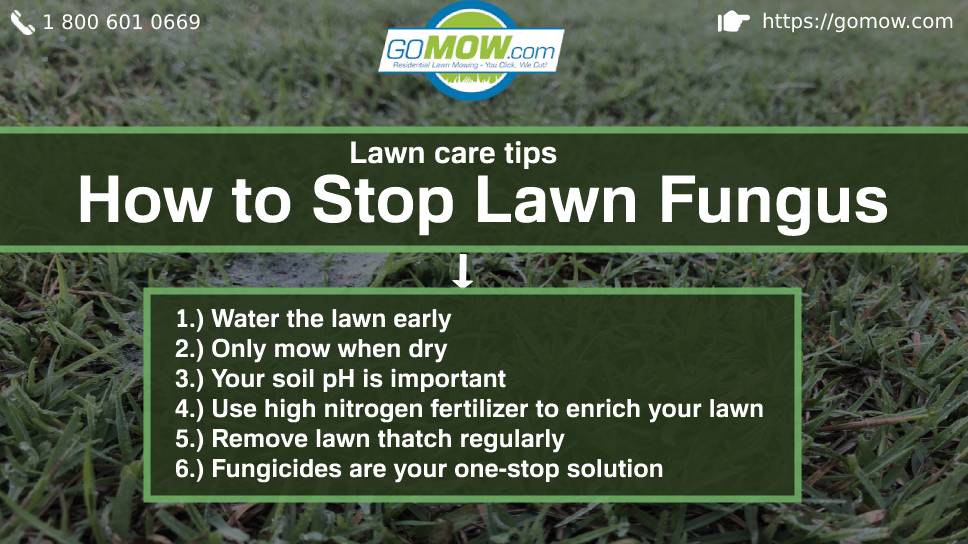Lawn Care Tips: How to Stop Lawn Fungus

Usually, lawn diseases will not cause major problems for lawns. Lawn care problems caused by fungus will only happen when there has been an extended period of exposure to heat and humidity and of course, negligence.
Lawn yards that experience a lot of users often get fungus attacks compared to those owned by homeowners. It stands to reason that the more exposure or activity that occurs on a lawn, the more prone it is to lawn disease, especially lawn fungus.
Regular lawn inspection from a lawn mowing service can help identify where your lawn is struggling early enough so treatment can be initiated to stop lawn fungus.
In this post, we have discussed several tips on how to stop lawn fungus:
-
Water the lawn early
Apply water on your lawn early in the morning rather than in the afternoon or evening. When the water in the morning, the plant roots are able to absorb as much water as needed for their activities. Watering in the afternoon or evening is not as effective as the sun evaporates a lot of the moisture before it soaks in. Evening watering is worse because the water keeps the lawn wet overnight and with no sun for photosynthetic activity, fungal diseases take root over time. Watering right is a key practice of stopping lawn fungus and should be taken very seriously. Lawn owners should consider having an automated sprinkler system installed or have a lawn care service handle watering for the best results.
-
Only mow when dry
The lawn should only be mown when dry to avoid spreading fungal spores all over it. Mowing too low or too high isn’t ideal generally for all lawn types. The recommended height to mow when the grass is dry is one-third of the length of the grass. Some species of grass will do well with 2.5 inches while others can take 3 inches. We advise due diligence and consulting your lawn mowing company to help confirm the lawn grass species you have on your lawn. Lawn mowing should only be embarked on when conditions are dry. Mowing wet grass is the fastest way of spreading lawn fungus around.
-
Your soil pH is important
The pH of your lawn yard soil should be between 6.0 and 7.0. Regular testings should be carried out during inspections to identify any anomalies and start treating them immediately. Consider adding lime to increase the acid concentration levels or sulfur to reduce it where necessary. Fungal growth can occur depending on your lawn soil’s pH. Control your pH and you have better chances of treating cases of wide-spread lawn fungus.
-
Use high nitrogen fertilizer to enrich your lawn
The use of high nitrogen fertilizer is very effective in keeping the lawn healthy and strong enough to fight off lawn fungus. Determine the amount of fertilizer it needs for optimal growth and have it applied by an experienced lawn maintenance company. If in doubt on the type or amount of lawn fertilizer to use, try a little amount of slow-release nitrogen fertilizer at a minimum of two times a year, during spring and after summer, then check for the outcome. If the grass appears to be doing badly, introduce more nitrogen fertilizer to it. Some grasses do well with only twice yearly fertilizer applications.
-
Remove lawn thatch regularly
Lawn thatch if left unattended can build up on your lawn yard surface causing harm to your lawn grass. Lawn thatch provides a damp breeding environment for microbes and fungus to grow and spread with abandon. Thatch blocks out air (oxygen), nutrients movement and retains moisture on the grass which encourages fungal spores to spread on the lawn. Dethatching should be done as often as they are discovered on the lawn. Mulch-mowing and composting can take care of the cut grass clippings that form thatch. If possible, these two practices should be taken up to cut off the incidence of thatch formation and the problems it brings.
-
Fungicides are your one-stop solution
If everything else fails, then consider having fungicides introduced into your lawn yard to stop lawn fungus. There are different variety of fungicides so choose a product that is suited for your lawn species.
This recommendation should come from lawn care experts who are experienced in lawn care in Texas. If you must handle your fungus treatment, please follow instructions to the letter to avoid mistakes. When in doubt, engage your lawn care company for support where needed. Fungicides are a guaranteed effective means of stopping lawn fungus so hold nothing back if this is the only option left to tackle the blight.
In conclusion, lawn fungus is a normal occurrence on a lawn and can be avoided with healthy lawn care practices. Mild fungus infection on the lawn can be stopped with adjustment in certain lawn care practices. If everything fails, consider introducing fungicides to combat and stop lawn fungus effectively.
Related Articles




